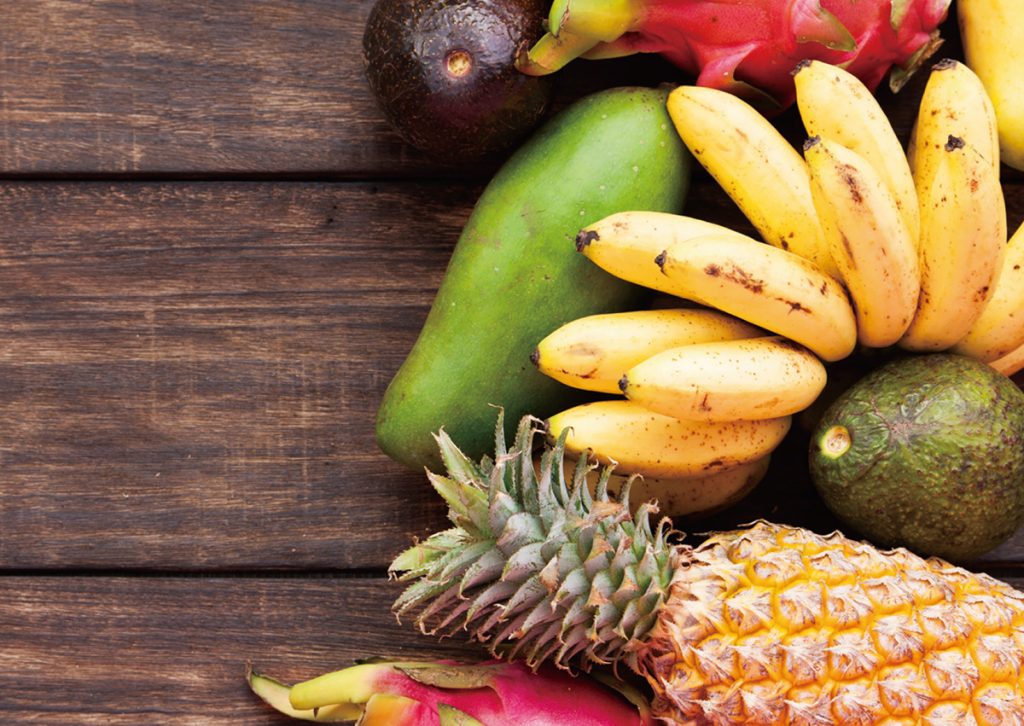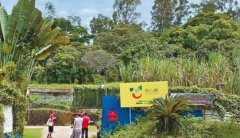The average operating area of organic fruit farm is nearly 3 hectares per household.
However, the business model of organic farmers is mainly diversified, and farmers will include the crops they want to grow now or in the future into the verified product projects, but there is a gap between the actual crop items planted by farmers and the registration data. if farmers are only classified according to their main business crop categories, it is difficult to grasp the cultivation status of organic agricultural products.
In order to describe the organic fruit industry in a more detailed and complete way, the study on "the Management and sales pattern of Organic Fruit Industry in Taiwan" was conducted in the Taiwan Organic Agriculture Information Network. The farms whose status is passed and the entries contain fruits in the screening system are taken as the matrix of the analysis data, and whether they grow organic "fruits" is determined by stocktaking. At the same time, the farm information of organic fruits collected in the previous 3 years is used for rectification. To explore the development of organic fruit industry and master the characteristics of operators, which can be used as a reference for industrial units to draw up guidance measures.
The object of the business profile is the farmers who have passed the organic verification (transition period) and whose registration projects contain organic fruits. On January 19, 109, 2240 farmers with fruit items were selected from the Taiwan Organic Agriculture Information Network. The repeated verifiers such as those who had visited or shared with others in the previous three years were excluded, and the check results were taken as the inventory roster for this year, a total of 1149 households. According to the inventory results of that year, 755 households were selected from farmers who actually planted organic fruits and those who were not legal persons. Add the stocktaking results of this year to the actual fruit farmers (730 households) planned in the previous three years to further understand the management situation and sample analysis of organic fruit farms, a total of 1485 households.

Management of organic fruit industry
First, the characteristics of the business owner
The operators of organic fruit farms are mainly male (75.8%) and female (24.2%). The highest educational level is "junior college and university" (38.2%), followed by "senior high school (vocational)" (29.2%). The average age is 55 years old, the most age distribution is "55 years old to under 65 years old" 560 people (37.7%), followed by 388 people (26.1%) in the "45 years old to under 55 years old" range. The average number of years engaged in organic business is 6.6 years, and more than half of them have been engaged in organic business for less than 10 years (a total of 75.4%), of which 633 (42.6%) are "less than 5 years", followed by 487 (32.8%). It shows that there is an increase in the number of farmers who have joined the organic ranks in recent years, and the owners of organic farms are young and highly educated.
II. Agricultural land resources
The average operating area of organic fruit farms per household is 2.9 hectares, of which the average organic farmland area per household is 2.3 hectares (accounting for 79% of the total operating area), and the non-organic area is 0.6 hectares (accounting for 21% of the total operating area). It shows that part of the land of the organic fruit farm is not cultivated organically, but according to the interviewed farmers, although the land has not been organically verified, part of its farming is still operated in a friendly way. The area of organic farmland leased and owned (including commission) is half, accounting for 51.7% (1.2 hectares) and 48.3% (1.1 hectares) of organic land, respectively.
Furthermore, the organic area of 1485 households with fruit cultivation is ranked from small to large, with a cumulative area of 3343.2 hectares, but the planting area of organic fruits is only 1940.6 hectares (58%). While the cultivation of other non-fruit crops reached 1402.6 hectares (42%), it is obvious that organic farmers have mixed cultivation as their management model. At the same time, diagonal (gray) farmers have a cumulative number of households and area of 2.3ha per household, so the overall distribution of organic farmland resources is quite uneven according to the cumulative total organic area (red). And from the circle selection in the picture, it is found that the cumulative slope of about 1000 households begins to rise, indicating that more than 70% of the households belong to small-scale operations.
III. Crop planting combination
According to the above picture, there are 613 fruit farmers with the largest number, accounting for 41.3%. Among the two crop categories, the combination of vegetables and fruits was 377 households, accounting for 25.4%, followed by fruit and special crops, 131 households, accounting for 8.8%. Across the three combinations, there were 129 households of special crops, vegetables and fruits at most, accounting for 8.7%, followed by 63 households of miscellaneous grains, vegetables and fruits, accounting for 4.2%. There are fewer farmers in the remaining 4 or more combinations, accounting for only about 5%.
To sum up, it shows that about 40% of farmers grow "fruit" on the farm, while in the combination of cross-category crops, the combination of fruits and vegetables is the most common, followed by the combination of fruits and special crops. In addition, the average organic area per household is 1.8 hectares, but with the increase of the number of crop combinations, the operation scale gradually expands, but the expansion of the scale is mainly due to the increase in the area of highly mechanized crops such as rice and miscellaneous grains.
IV. General situation of fruit cultivation
To further explore the general situation of fruit cultivation in organic farms, first of all, the fruits are classified into big berries, small berries, pear fruits and so on. For organic fruits, the planting area of large berries is the most extensive, followed by pear fruits of 511.5 hectares, citrus fruits of 344.2 hectares, and the most widely planted areas in the south, followed by the eastern region, followed by the central region. Large berries and pears are mainly grown in the southern region, there are also many citrus crops in the eastern region, large berries are the largest in the middle, and citrus crops are mainly in the northern region.
In the cumulative area of fine fruit crops that farmers choose to plant, the planting area of plum, pineapple, banana, red dragon fruit and lemon is larger, indicating that organic farmers prefer to cultivate and manage more extensive fruits in the choice of fruit planting; on the other hand, due to small-scale mixed planting, there is also a considerable area that cannot be cut in the survey.
Organic fruits are mainly sold by themselves.
In terms of the sales channels of organic fruit farms, this paper analyzes the sales channels of farmers' main crops. Organic fruit farms sell organic agricultural products by themselves and sell them to carriers in the same proportion, but as a whole, "self-sale" is still slightly higher, accounting for 763 households (51.4%), of which "self-selling at home" channel is the most, accounting for 451 households (30.4%). Followed by the "farmer bazaar, farmer direct sales station" channel, 159 households (10.7%) The total number of "sold to carriers" is 599 (40.3%), of which the largest number is "traffickers and wholesalers", accounting for 243 (16.4%), followed by "supermarkets and retail stores" with 169 (11.4%). There are 123 unsold households (8.3%).
Counseling resources to encourage farmers to transform into organic agriculture. In recent years, there has been an increase in the number of farmers joining the organic ranks, but because of its latitude, Taiwan is vulnerable to climate and many diseases and insect pests, and because of the long growth period of fruit trees, compared with vegetables and rice, organic cultivation of fruit trees is the most difficult. However, sustainable profit is the main factor supporting the sustainable development of this economic activity, and the profit conditions depend on its competitiveness.
Therefore, in addition to high yield and quality as the goal to be pursued continuously, it is also necessary to guide farmers to enter the field of organic cultivation of crops that have not yet been organically cultivated at the present stage, so as to increase the competitiveness of products; at the same time, cooperate with expanding business scale to reduce transaction costs and expand diversified marketing channels to stabilize income and accelerate the development of domestic organic agriculture.
- Prev

Four Life Ecotourism, Organic Farms Become Conservation Biological Paradise
Organic certified ecological farm, a paradise for rare animals and plants The original site of the former sugar cane field, after 60 years of customary monoculture cultivation, the ecology is relatively simple. After the manor lease took over, after 16 years of efforts, the original land, transformation
- Next

Fanling organic farm launches multi-experience such as farm feast and pancake workshop
Unable to travel under the epidemic, many people want to find the pleasure of traveling in the wild. Earlier, I made an organic farm tour to enjoy Cuiyi and taste fresh food. I had the feeling of being in Western Australia, and it was even more exciting that I could still come to the hotel to enjoy it.
Related
- A one-day flower show brings 130 million yuan in orders! Nanhai, this Phalaenopsis exhibition is amazing
- What do the flower language and meaning of Lutheran tree mean? Precautions for planting Lutheran tree
- Encounter Chaoshan Kongfu tea, not without this cup of Phoenix single clump
- The durian market in Vietnam and Thailand is flooded. The price of imported durian has plummeted by 30-40% in a month.
- Shanghai solved the problem of local vegetable supply by planting 80,000 mu of green leafy vegetables.
- Wageningen University has become the best agricultural university in the world for the seventh time in a row.
- The strongest export season of South African grapes is full of challenges, with exports to Russia falling sharply by 21%.
- Sri Lanka is on the verge of bankruptcy, "Tea for debt" Organic Agriculture Revolution aggravates the Food crisis?
- Turning waste into earthworm manure and worm manure into organic fertilizer-A new choice for auxiliary farming
- Organic rice growers shoulder the responsibility of nurturing agricultural talents! Yinchuan Sustainable Farm with Organic Life Camp

